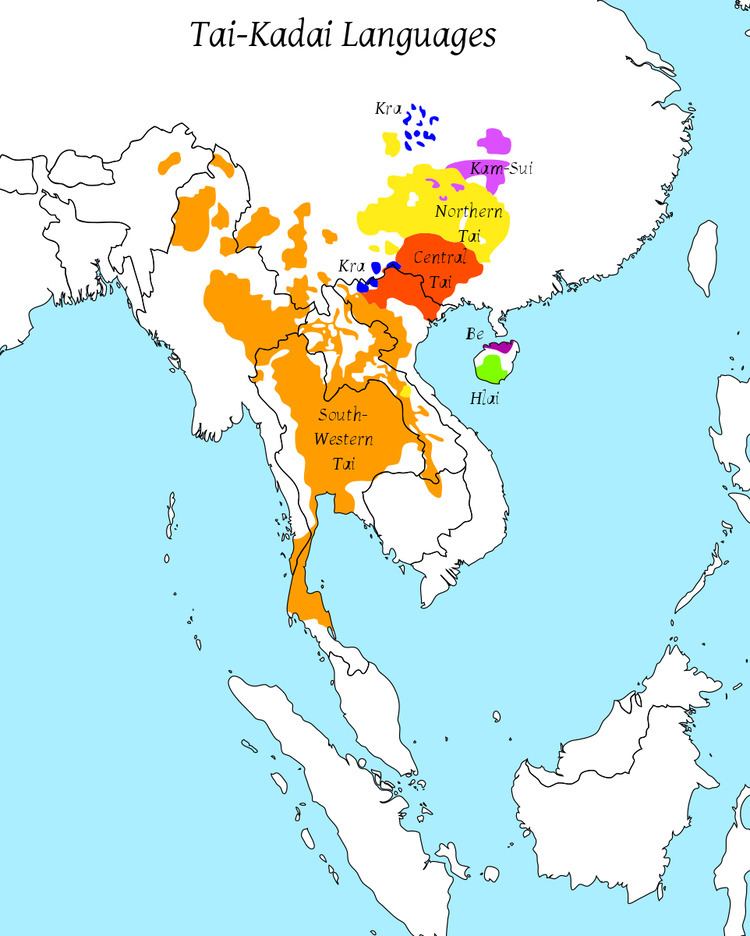Glottolog daic1237 | ISO 639-2 / 5 tai | |
 | ||
Linguistic classification Tai–KadaiSouthernBe–TaiTai Subdivisions Northern (NT)? Central (CT)Southwestern (SWT)(see also Zhuang languages) | ||
The Tai or Zhuang–Tai languages (Thai: ภาษาไท or ภาษาไต, transliteration: p̣hās̛̄āthay or p̣hās̛̄ātay) are a branch of the Tai–Kadai language family. The Tai languages include the most widely spoken of the Tai–Kadai languages, including standard Thai or Siamese, the national language of Thailand; Lao or Laotian, the national language of Laos; Myanmar's Shan language; and Zhuang, a major language in the southern Chinese province of Guangxi.
Contents
Name
Cognates with the name Tai (Thai, Dai, etc.) are used by speakers of many Tai languages. The term Tai is now well-established as the generic name in English. In his book The Tai-Kadai Languages Anthony Diller claims that Lao scholars he has met are not pleased with Lao being regarded as a Tai language. For some, Thai should instead be considered a member of the Lao language family. One or more Ancient Chinese characters for ‘Lao’ may be cited in support of this alternative appellation. Some scholars including Benedict (1975), have used Thai to refer to a wider (Tai) grouping and one sees designations like proto-Thai and Austro-Thai in earlier works. In the institutional context in Thailand, and occasionally elsewhere, sometimes Tai (and its corresponding Thai-script spelling, without a final -y symbol) is used to indicate varieties in the language family not spoken in Thailand or spoken there only as the result of recent immigration. In this usage Thai would not then be considered a Tai language. On the other hand, Gedney, Li and others have preferred to call the standard language of Thailand Siamese rather than Thai, perhaps to reduce potential Thai/Tai confusion, especially among English speakers not comfortable with making a non-English initial unaspirated voiceless initial sound for Tai, which in any event might sound artificial or arcane to outsiders.
According to Michel Ferlus, the ethnonyms Tai/Thai (or Tay/Thay) would have evolved from the etymon *k(ə)ri: 'human being' through the following chain: kəri: > kəli: > kədi:/kədaj (-l- > -d- shift in tense sesquisyllables and probable diphthongization of -i: > -aj). This in turn changed to di:/daj (presyllabic truncation and probable diphthongization -i: > -aj). And then to *dajA (Proto-Southwestern Tai) > tʰajA2 (in Siamese and Lao) or > tajA2 (in the other Southwestern and Central Tai languages by Li Fangkuei). Michel Ferlus' work is based on some simple rules of phonetic change observable in the Sinosphere and studied for the most part by William H. Baxter (1992).
Many of the languages are called Zhuang in China and Nung in Vietnam.
History
Citing the fact that both the Zhuang and Thai peoples have the same exonym for the Vietnamese, kɛɛuA1, Jerold A. Edmondson of the University of Texas at Arlington posited that the split between Zhuang (a Central Tai language) and the Southwestern Tai languages happened no earlier than the founding of Jiaozhi in Vietnam in 112 BCE but no later than the 5th-6th century AD. However, based on layers of Chinese loanwords in Proto-Southwestern Tai and other historical evidence, Pittayawat Pittayaporn (2014) suggests that the dispersal of Southwestern Tai must have begun sometime between the 8th and 10th centuries AD.
Haudricourt (1956)
Haudricourt emphasizes the specificity of Dioi (Zhuang) and proposes to make a two-way distinction between the following two sets. The language names used in Haudricourt's (1956) original are provided first, followed by currently more widespread ethnonyms in brackets.
Characteristics of the Dioi group pointed out by Haudricourt are (i) a correspondence between r- in Dioi and the lateral l- in the other Tai languages, (ii) divergent characteristics of the vowel systems of the Dioi group: e.g. 'tail' has a /a/ vowel in Tai proper, as against /ə̄/ in Bo-ai, /iə/ in Tianzhou, and /ɯə/ in Tianzhou and Wuming, and (iii) the lack, in the Dioi group, of aspirated stops and affricates, which are found everywhere in Tai proper.
As compared with Li Fang-kuei's classification, Haudricourt's classification amounts to consider Li's Southern Tai and Central Tai as forming a subgroup, of which Southwestern Tai is a sister: the three last languages in Haudricourt's list of 'Tai proper' languages are Tho (Tày), Longzhou, and Nung, which Li classifies as 'Central Tai'.
Li (1977)
Li Fang-Kuei divided Tai into Northern, Central, and Southwestern (Thai) branches. However, Central Tai does not appear to be a valid group. Li (1977) proposes a tripartite division of Tai into three sister branches. This classification scheme has long been accepted as the standard one in the field of comparative Tai linguistics.
Gedney (1989)
Gedney (1989) considers Central and Southwestern Tai to form a subgroup, of which Northern Tai is a sister.
Overview
In a 2009 Ph.D. dissertation, Pittayawat Pittayaporn classifies the Tai languages based on clusters of shared innovations (which, individually, may be associated with more than one branch) (Pittayaporn 2009:298). In Pittayaporn's classification system, the Zhuang varieties of Chongzuo in Guangxi have the most internal diversity. Only the Southwestern Tai branch remains unchanged from Li Fang-Kuei's 1977 classification system, and several of the Southern Zhuang languages allocated ISO codes are shown to be paraphyletic. The classification is as follows:
Standard Zhuang is based on the dialect of Shuangqiao (双桥), Wuming District.
Sound changes
The following phonological shifts occurred in the Q (Southwestern), N (Northern), B (Ningming), and C (Chongzuo) subgroups (Pittayaporn 2009:300–301).
Furthermore, the following shifts occurred at various nodes leading up to node Q.
Reconstruction
Proto-Tai has been reconstructed in 1977 by Li Fang-Kuei and by Pittayawat Pittayaporn in 2009.
Proto-Southwestern Tai has also been reconstructed in 1977 by Li Fang-Kuei and by Nanna L. Jonsson in 1991.
Comparison
Below is comparative table of Tai languages.
Writing systems
Many Southwestern Tai languages are written using Brahmi-derived alphabets. Zhuang languages are traditionally written with Chinese characters called Sawndip, and now officially written with a romanized alphabet, though the traditional writing system is still in use to this day.
